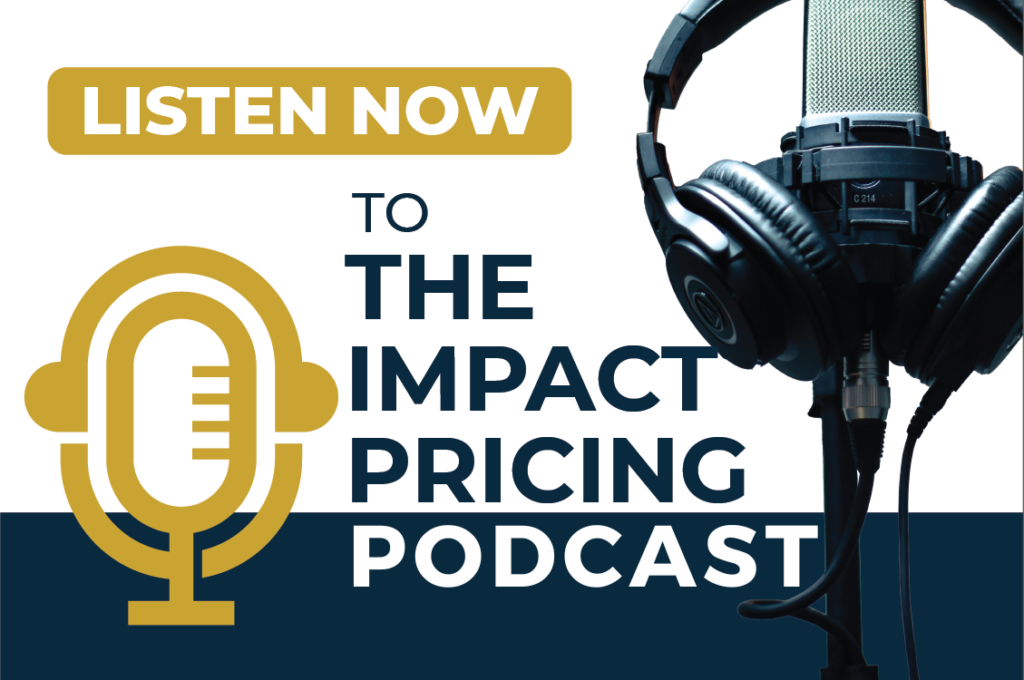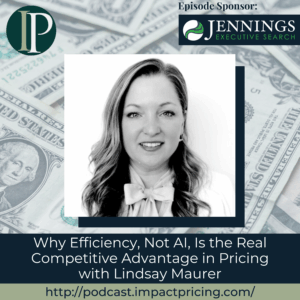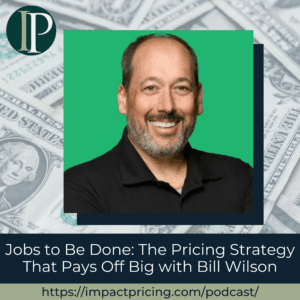David Mok is a global marketing executive, a pricing champion & thought leader, a change agent, and he helps companies improve bottom-line profit.
In this episode, David deep dives into the importance of pricing to the company’s bottom line, and why as a product manager you must have a price strategy that gets everybody in the organization aligned to it.
Podcast: Play in new window | Download
Why you have to check out today’s podcast:
- Know what is the critical role of pricing people to your company’s bottom line
- Learn why there is a need to have pricing people in an organization
- Discover the importance of really knowing your target audiences in relation to price and value setting
“Once we ascertain what a product is worth and to whom, which in theory defines the customer’s willingness to pay, the next question we ask ourselves is, ‘What do we want to do that is from a strategy perspective.”
– David Mok
Get Accelerate Your Subscription Business: Your Blueprint to Packaging & Pricing for Growth Course at https://www.championsofvalue.com
Topics Covered:
01:18 – What led him to pricing and his thoughts about it
03:15 – Talking about pricing people and the need to have it in the organization
06:11 – Skillsets required of a great pricing person
10:52 – Do pricing people not have this leadership influence capability
13:39 – What makes pricing an interesting field
16:52 – Why companies need to be value-based businesses
18:46 – What is a “Pricing Canvass Framework”
20:48 – Why it’s hard to value a product and determine it’s worth to someone
23:44 – What could be the likely reason for people not to know their target customer so well
24:58 – His Pricing piece of advice: “A piece of advice is don’t boil the ocean, know what you can influence, start small. get some success, and continue to build on success. If you are the product manager, my advice is to have a price strategy and get everybody aligned to it.”
Key Takeaways:
“I would say people generally have an idea who their customers are, but they don’t understand what is it that they value .” – David Mok
“Think about your role and what you can control. There are a number of things we could do in pricing, don’t try to boil the ocean.” – David Mok
“If you are a product manager, my advice is to have a price strategy and get everybody aligned to it.” – David Mok
Connect With David Mok:
- Email:: [email protected]
Connect with Mark Stiving:
Full Interview Transcript
(Note: This transcript was created using Temi, an AI transcription service. Please forgive any transcription or grammatical errors. We probably sounded better in real life.)
David Mok: Once we ascertain what a product is worth, and to whom, which in theory defines the customers willingness to pay. And the next question we ask ourselves is, “Well, what do we want to do?” That’s from strategy perspective.
[Intro]
Mark Stiving: Welcome to Impact Pricing, the podcast where we discuss pricing, value, and the hopefully healthy relationship between them. I’m Mark Stiving, today our guest is David Mok. Here are three things you want to know about David before we start. He is Senior Director of Pricing, Strategy, and Analytics at Johnson & Johnson. Huge title. He’s done pricing in semiconductors and hard disks, fields that I personally have experience in, and love those fields. But I think what we’re going to talk the most to him about today is, he teaches a pricing class at UC Berkeley. And by the way, that’s where I got my doctorate. Welcome, David.
David Mok: Hey, I’m glad to be here, Mark, and I thank you for having me.
Mark Stiving: Hey, it’s going to be fun. It’s going to be fun. Hey, let’s start, how did you get into pricing?
David Mok: Yeah, it’s quite an interesting question. I would say I actually stumbled upon it.
Mark Stiving: I think most people do, by the way.
David Mok: Very early on, I start as a product manager, when I worked at a semiconductor company. I love product management, you know, largely worked in launching new products. And one day, one of the senior directors asked me if I want to go over to pricing, and I said, “No.” I actually like what I’m doing, product management. And next thing I know, even though I said no, I was over there. And that’s kind of how my career in pricing started. So yeah, I kind of stumbled upon it.
Mark Stiving: Well, here’s the interesting question, are you happy that you got shove into pricing?
David Mok: Yeah, I think I am. I think what’s quite intriguing about pricing is it’s a field that touches so many different parts of the organization. And what I mean by that is, in order to do well in pricing, you have to really know product management quite well. You need to understand the customer very well as well. You need to understand, be able to dialogue with our finance people. So, one of the things that I discover is in order to pricing well as a multi-disciplinary area, where you tend to develop expertise in a lot of different areas. You develop expertise in costing, finance and product management, and sales and negotiation, right? So, it’s been a fabulous ride, a fabulous career, so I thoroughly enjoyed it.
Mark Stiving: I couldn’t agree with you more in terms of, we touch so many different places inside an organization. We have to understand all those different roles. We have to be able to talk to them, communicate with them, influence them. So, I love the concept of pricing, I think it’s a blast, so.
Let’s talk about pricing people today. Not putting prices on people, but let’s talk about the world of people and pricing people. Do you have pricing people who work for you now?
David Mok: I do. Yeah, I started as a force of one here at Johnson & Johnson a number of years ago. And we actually grew the team now to, on my side we have a team of 10.
Mark Stiving: Nice.
David Mok:
And it’s a building, it’s a function that we’re continuing to build, just because I think companies realizing that it’s really an important part of our, sort of important part of our business. Where I would say several years ago, hasn’t been a focus of the company. And it hasn’t been a focus of company just because pricing was actually quite simple to hear on healthcare, because, you know, one thing we would do is we would, you know, raise prices and if you didn’t get the price right out of the gate, you know, the company will tend to raise prices at least once, if not twice a year. So, any, since you’ve committed gets easily rectified. But in today’s world, healthcare, it’s actually the opposite, right? Where pricing is actually under a lot of pressure. And industry, women’s pay is coming down, so the need to develop pricing expertise, and to build pricing muscle across the company is really, really important because if you think about some of the challenges that we have, let’s just play around some simple math.
Mark Stiving: Okay.
David Mok: And I’m going to just talk generic term. For a $1 billion business, let’s just say if you lose say, you know, 1% on price, what does that work out to be?
Mark Stiving: That’s only $10 million.
David Mok: That’s $10 million.
Mark Stiving: Almost as much as I make a year.
David Mok: Right. So, what if you lose like 5% on price? 50 million dollars, right? So, let’s just take some nice round numbers and it does not reflective of a company-specific item. But let’s say, a billion-dollar, nice round number, you lose 5% of the price, $50 million. How are you going to make up $50 million, right? And just ask yourself, what is the average product launch? What do you actually get out of the average product launch, right? You know, a lot of the product launch are not big ones. So, you might actually, you know what makes up for $50 million, you might have to have lots of product launches, just to make that up.
Mark Stiving: Yeah. And that 50 million, by the way, is all profit dollars.
David Mok: That’s right.
Mark Stiving: So, you might need to do 100 million or 200 million if you actually want to replace those profit dollars.
David Mok: That’s exactly right, right? And so, what a lot of people don’t realize, and the math is actually quite simple as we just went through, is that is one of the most powerful levers that are in your control to deliver bottom-line profit.
Mark Stiving: Yeah, absolutely. Absolutely. Well, let me ask you, what skill sets do you think to make a great pricing person? So, you think about the people that are on your team, think about the skills that you’ve used over the course of your career.
David Mok: Yeah, that’s an interesting question, Mark. And I think the answer is, it depends. In world pricing, there’s a number of areas you can get into. You could get into the deal desk side, which is you spending your time largely with salespeople, negotiating a deal, and it gets very, very tactical. You could get into pricing that could be more strategic, right? Which means you’re working closer to marketing, product management, and even R&D with new products, right? Or you could be in pricing where you’re dealing with systems and tools. And you could have pricing that you could focus on within a region, or you could have pricing that’s a focus on globally. So, let’s just think about that for a second. So, let’s think about, wow, pricing can cover so many different areas.
David Mok: Now to get back to answer your question, Mark, if your focus is going to be more around the price-setting piece, you tend to work closer with Product Marketing, Product Management, right? Arguably even R&D, right? And so, the skill sets you have to have the way to look at that is if I could put a simply, is someone that knows marketing very well, but have deep focus and expertise on pricing. Now on the flip side, if you’re more on the deal desk side, I think the skill sets that’s needed in pricing would be someone that would know negotiation very well. Someone that has a thick skin, someone who can just operate objectively by, you know, standards. It’s someone that, you know, salespeople can work with, right?
David Mok: And so that’s the kind of skill sets that you might need and certainly financial savvy as well. But because the range of pricing spans very different areas, you need a mix of those skill sets. Now imagine if one of these days you want to become a global pricing leader, and all these things come to play. So, think about the skill sets that you have to build, right? So, from, from price setting, which is people to converse with strategically at the global level, at the product management level, and arguably even R&D level. And yet, you can actually talk to salespeople negotiate customers, go meet customers, talk to them. And that’s really the quite exciting part of pricing is because it covers that span of the area and eventually you may want to launch enterprise pricing software. So, then you have to develop skills in terms of how you would deploy pricing software. It covers the gamut of all the things we just talked about. And if you get into a global role, then how would, and be able to manage pricing across the different parts of the world.
Mark Stiving: So, I actually love that answer, David. Usually, when I answer that question, I answered, I say, there are three things that I, I use the word pricing champion needs. And those three things are they have to be really an expert in pricing. So, you have to understand pricing and all the strategies and things like that. You have to be comfortable with data. You don’t have to be a statistician, but you have to be comfortable looking at it, knowing what’s possible. And then the third one, which is the one that I think most pricing people don’t have, is the ability to, is leadership, essentially. It’s the soft skills, how do I influence people? How do I work with teams, so that I can really make big things happen inside my company?
David Mok: Yeah, and I want to build on your third point you mentioned, Mark, right? I’ve been doing pricing for a number of years, there are very few things I actually own, right?
Mark Stiving: Yeah.
David Mok: Because if you think about, “Hey, I’m working with the Product Manager,” well, who owns the product strategy? Well, it was the product manager, right? Or I’m working with the account team, or who owns the relationship with the account team, who owns the account strategy? Well, it’s the, as a field. So, in pricing, there are very few things that we actually own. That means a bulk of what we do is really around influence. Our ability to influence across the organization, and sometimes that’s tough.
Mark Stiving: Yeah. And so, let me, I’m going to put some horrible words in your mouth and so you can take them back out in just a second. People who tend to go into pricing seem to me to be more nerd-like, number crunching, and they tend not to have this leadership influence capability. Would you agree, disagree? What do you think?
David Mok: Yeah, there’s certainly, that there is a segment of roles within pricing where what you just said, Mark, I think it’s absolutely needed. And I would say those people are like your data scientists, right? So, these people will understand, you know, different ways of looking at data. They can, and it’s critical, and that part of pricing is critical. And those are skill sets where a lot of people don’t have is, how do you actually look at data? And how do you make sense of data? And people with a strong analytical, operational background are really quite important, right?
Now, having said that, oftentimes, I think, you know, people with that background where, you know, how do we get value, you know, how do they add value in the organization is, they’re going to need to either interface with people that are closer to, you know, what’s customer-facing? Really understand the realities of the marketplace. And be it’ll make sense of that data. Because sometimes when you look at, I’ll give you a great example, right? And sometimes we would work, would have data scientists who would come in and say, “Hey, based on my elasticity modeling, we think you should, your price should be able to go from x, your price should be able to go from x to y, and you should be able to drive this number.”
David Mok: But the reality is, in some cases, and this is the reality part that I want to talk about is, in one part of our business are, you know, we’re not a retail organization. And so, a lot of our demand is not direct demand, meaning I communicate directly to my end consumer and a lot of demands, derived demand, mean I interface with the intermediary, which then interface with the end consumer. So, any elasticity modeling there doesn’t really pan out, right? So those are some examples of where I think in order for some of those, I think you call them a nerd like, number-crunching folks, it’s right there. Absolutely needed, really valuable, in my opinion, but to bring value to that is to having have those people collaborate, work very, very closely hand in hand with the people that are in the day to day, who actually understands the day to day operations of how things really work with the customers. And strategically what we want to go what we want to drive.
Mark Stiving: Yeah. And I think the people who do the day to day work, the pricing strategist, let’s call them, for the sake of argument, I think these people have to understand what’s possible with data. What data do we have, what kind of information might be hidden in there? They may not know how to get it out but they ought to be able to say, “Look, here’s a model, let’s go test this model.”
David Mok: Yeah, I think that’s exactly right, Mark. And I think that’s the happy partnership between the two different sets of organizations. And that’s why pricing is such an interesting field because if you’re looking for a career in pricing, it touches so many different areas from systems, tools, what we just talked about, the deep data size analytics, the tactical piece, the customer facing, the strategic thinking, the price setting, right? The driving an entire region strategy. So, you can see it all those things require different skill sets. And that’s why I think over time as pricing starts evolving, it’s really a, I think a fantastic opportunity for anyone looking to make a career out of pricing. Or even if you do a short tour in pricing, right? A number of those few will actually make you, if you’re a product manager, will make you becoming better product manager for instance, right? Or if you’re a salesperson, maybe make you a better salesperson. If your marketing person, it actually makes you think, it will help you actually make become a better marketer because it forces you to think through things that you might have just glossed over on the pricing side, so.
[AYSB Ad]
Time out real quick add, if you’re currently working on a subscription business, I’m guessing this is what your world feels like, Oh my gosh, the CEO just said, we need to grow faster. I already have too many things to do now, what are we adding? Which of these things should I be doing? If I only sleep for hours and I come in earlier, I can get more done?
Well, here’s my advice. You can go with the flow and do what you’re told. I mean, doing busy work and doing what other people tell you to do isn’t the worst job in the world. After all, I used to dig ditches for a living or there’s a better alternative. Take responsibility. You determine what drives your product’s growth. When you choose the right activities and then execute them well, it boosts your career.
To help you drive your product’s growth, we put together a powerful online course called Accelerate Your Subscription Business. This course provides you the framework that helps you decide which of your tasks are most important right now. And most importantly, though, it helps us think strategically about your subscription business, not just about your tactics.
Time out real quick add, if you’re currently working on a subscription business, I’m guessing this is what your world feels like, “Oh my gosh, the CEO just said, we need to grow faster. I already have too many things to do now, what are we adding? Which of these things should I be doing? If I only sleep for hours and I come in earlier, I can get more done?”
Well, here’s my advice. You can go with the flow and do what you’re told. I mean, doing busy work and doing what other people tell you to do isn’t the worst job in the world. After all, I used to dig ditches for a living, or there’s a better alternative. Take responsibility. You determine what drives your product’s growth. When you choose the right activities and then execute them well, it boosts your career.
To help you drive your product’s growth, we put together a powerful online course called Accelerate Your Subscription Business. This course provides you the framework that helps you decide which of your tasks are most important right now. And most importantly, though, it helps us think strategically about your subscription business, not just about your tactics.
The course is only $500. What a tiny investment, considering what this can do for your company and your career.
Mark Stiving: I believe wholeheartedly that companies should be, I call them value-based businesses, which means that as a company, we should be creating, communicating and capturing value. And the only way we do that is to understand what value really means. And its pricing people who know that. We don’t know how consumers value our products, but we know how to think about value, we know how to help the rest of the company understand this is what value is.
David Mok: Yeah, and that’s really important point, Mark, because if I’m to simplify pricing to these two things, it’s really this. And I know I’m oversimplifying this. But the first question when we go about developing pricing strategy, first question we ask is this, we say, we ask ourselves, “What is this product worth, and to whom?” Boils down to, what’s the value of this product? And unless you know that, it’s hard to do anything beyond that. Once we ascertain what a product is worth, and to whom, which in theory defines the customers willingness to pay. And the next question we ask ourselves is, “Well, what do we want to do?” That’s from a strategy perspective. What do we want to, you know, go after the whole market? Do we want to be a niche player? Do we want to be a premium, do you want to charge a premium? There’s a whole number of things that we can do in terms of strategy. So, if I have to leave your audience with two simple things to think about, right? The first thing to think about is, what’s your product worth and to whom, right? Second question is, what do you want to do? And that, I think when you think through a number of those things around, pricing around those elements, I think it’ll help you have a more commercial, successful strategy.
Mark Stiving: I love those two, I think they’re really, really powerful, so. Hey, let’s, let’s switch gears just slightly, since you teach, do you teach an undergrad class and an Exec-ed Class on pricing at Berkeley?
David Mok: Yeah, I teach the executive education class at Berkeley. So specifically, in the product management program, and every once in a while, I think Berkeley does a specific pricing course, I teach both of those courses.
Mark Stiving: Okay. And what I want to know is, what do you teach? Or what do you, what are the skill sets that we teach? And, I don’t know, which one do you think is more interesting? I would say executive education is probably more interesting. Let’s do that first.
David Mok: Yeah, executive education is kind of where I spend my time, right? And I think a lot of students going, the profile of students coming there, a number of them already have their MBA program. They may or may not have pricing background. And a lot of them are technologists. So, one of the things that we try to do there at Berkeley is have a mix of theoretical, which is from the university staff, and a mix of practical, which is someone like myself who’s a practitioner in there. And so one of the things we actually go over on the pricing section, because it’s largely a class of product managers looking to, you know, launch new products or disrupt the world of the things that we’re working on, is to really help them think through, you know, where does price play within their commercial strategy, right? And those two points that I, that we just articulated a few minutes ago, we spend a lot of time talking through those two points. And the way we talk through those two points is we use something that what we create is called pricing canvas framework that I use at the university scene, that I actually use here at Johnson & Johnson and it’s been a very, very useful framework that we use here in a company. And I think students at Berkeley also find it quite useful.
David Mok: So, the pricing canvas really focused around those two points we talked about earlier, “Hey, what’s your product worth, and to whom?” And, “What do you want to do?” And we start with, everybody starts with who’s your target customer. And then based on our target customer, and then the building blocks are your target customer. And we talk about your market strategy, market strategy, basically, essentially, what’s your goal and what your strategic imperatives to achieve those goals and put another way the cover we win, right? And then we talk about, you know, your value proposition, your offering structure, and then we get into the price level or the price strategy, and then we get into price rules and policies. So that’s a framework that we use to actually educate the product manager. And we’ve been doing that for a few years and seems to be working quite well.
Mark Stiving: Nice, very glad to hear that. I find, tell me if you think this is right or not, but I find that most people can’t answer that first question that you ask, and that’s what’s the value of the product? Or what’s it worth to somebody? And I think that if we could get more people just to think about that, it would change business.
David Mok: Yeah. You know what, Mark, you’re 100% spot on. And the reason why, I think part of the reason why people struggle to answer that question, I would say is twofold. First, I think most, everybody think they know who the target customers. And I’ve been working with hundreds of product managers over the years between, you know, just my job, between what I do at work, and the university setting. I could honestly say, the one area where people often don’t do as good of a job as they should identify who ultimately is their target customers. The typical response I would hear from product manager, they say, “Hey, my target customer is, I want to go after our competitive or customers who are using our competitive products, right? I say, okay. And that’s typically the comment I would hear. But in reality, the way we like to think about, you know, who your target customer is, is just thinking about, well, what’s the job? Is the jobs to be done framework that we like to use or think of?
And then what jobs are we trying to, we try to help the customer do a better job of, right? So, you think about segmentation through a jobs framework and at the end of the day, there’s a job that a customer wants to get accomplished. And in trying to accomplish that job, you know, your customers go face all these obstacles. So how does our product actually help the customer achieve that job while overcoming those obstacles? And that starts defining what is your product worth? Because sometimes you can say, “Hey, my product, instead of turning three times, I can accomplish the job in turning one time.” Well, honestly, is that really important to the customer, right? It could be different, but is it really important? So, it’s really trying to understand things that are really important to the customers, that’s differentiated, right? And our ability to accomplish what that job can be done. And once you understand that, that there’s a number of techniques, you could read from a book anywhere around, you know, how would you quantify your worth, you could do market research around that. And there’s a whole bunch of techniques that’s out there to do that. But I would say the starting point is really understanding who really is your target customer, and really understanding what are they actually trying to get accomplished, and how do you do it better than their next best alternative solution?
Mark Stiving: Yeah, I got to ask the question on the target customer, though. Do you think people don’t know their target customers because they don’t know it? Or they’re afraid to focus?
David Mok: Well, I would say, I would say people generally have an idea who their customers are, but they don’t understand what is it that they value? And in order to truly understand what they value, I think that’s what I kind of talked about, is really fully understanding what exactly, gets back to the job discussion that we just talked about, right? And that’s a struggle that I see, and people don’t necessarily think through that, as well as I think as they can be. And I think everybody knows who they’re currently selling to, who the customers are buying. But I don’t think they fully grasp what the customer’s trying to get done. And what is really, truly important to them, and how they’re offering is something that’s above and that actually creates value above and beyond their next best alternative. I think that’s the struggle.
Mark Stiving: I could see that completely. Absolutely. David, I have been having a blast doing this, but it looks like we’re out of time. Before we wrap it up, though, what’s one piece of pricing advice you would give our listeners that you think could have a big impact?
David Mok: Yeah, I would say the one piece of advice knows, you know, think about your role and what you can control. There are a number of things we could do in pricing, right? And don’t try to boil the ocean. And if you’re, let’s say if you’re a product manager, so typically what does a product manager control? Well, in theory, he should control the commercial strategy, and the price is part of a commercial strategy. So, I would say, a piece of advice is don’t boil the ocean, know what you can influence, start small, get some success, and continue to build on success. If you’re the product manager, my advice has a price strategy and get everybody aligned to it. And if I asked you this very simple question, a question about your product is, what is your price strategy? And if you are fumbling for words right now, I would argue that you don’t have one. So, my first piece of advice is to have a price strategy and get alignment.
Mark Stiving: Nice. Excellent. David, thank you so much for your time today. If anybody wants to contact you, how can they do that?
David Mok: They can reach me at my personal email at David, T, as in Tom, dot M, OK. at Gmail dot com. So that’s [email protected].
Mark Stiving: Perfect. Episode 48, all finished. I got to say my favorite part of today was when we talked about the different roles based on what type of pricing, or what part of pricing we’re going to be in. David, did you have a favorite part?
David Mok: I think my favorite part is, I actually enjoyed the work and the product managers and a strategic pricing side. So, I enjoyed that thoroughly.
Mark Stiving: Nice, nice. And to our listeners, what was your favorite part? If you have one, please let us know in the comments of wherever you downloaded and listened. While you’re at it, would you please give us a five-star review. They’re very helpful to us. And remember, we launched a new community called Champions of Value dot com. If you go to community.championsofvalue.com, you can see all of the writings and things that I publish for free, they’re available there. And that’s where we have most of our conversations. If you have any questions or comments about the podcast or about pricing in general, feel free to email me [email protected].
Now, go make an impact!
**Note: Mark Stiving has an active LinkedIn community, where he participates in conversations and answers questions. Each week, he creates a blog post for the top question. If you have a question, head over to LinkedIn to communicate directly with Mark.
Tags: Accelerate Your Subscription Business, ask a pricing expert, pricing strategy















